Stepping onto a thoughtfully finished deck floor is like crossing a threshold from routine to retreat. Whether you crave barefoot comfort, crave-worthy style, or year-round durability, the right surface quietly influences everything from morning coffee rituals to sunset gatherings. Advances in materials now let homeowners mix traditional warmth with modern resilience, making deck flooring a surprisingly creative design arena. As technology unlocks richer colors, smarter coatings, and eco-friendly production, even ordinary backyards can feel resort-worthy without constant upkeep. Dive into these twenty ideas to discover practical options that respect budgets, climates, and personal style—and notice how each choice turns square footage into an inviting stage for life outdoors.
1. Pressure-Treated Wood Deck Flooring
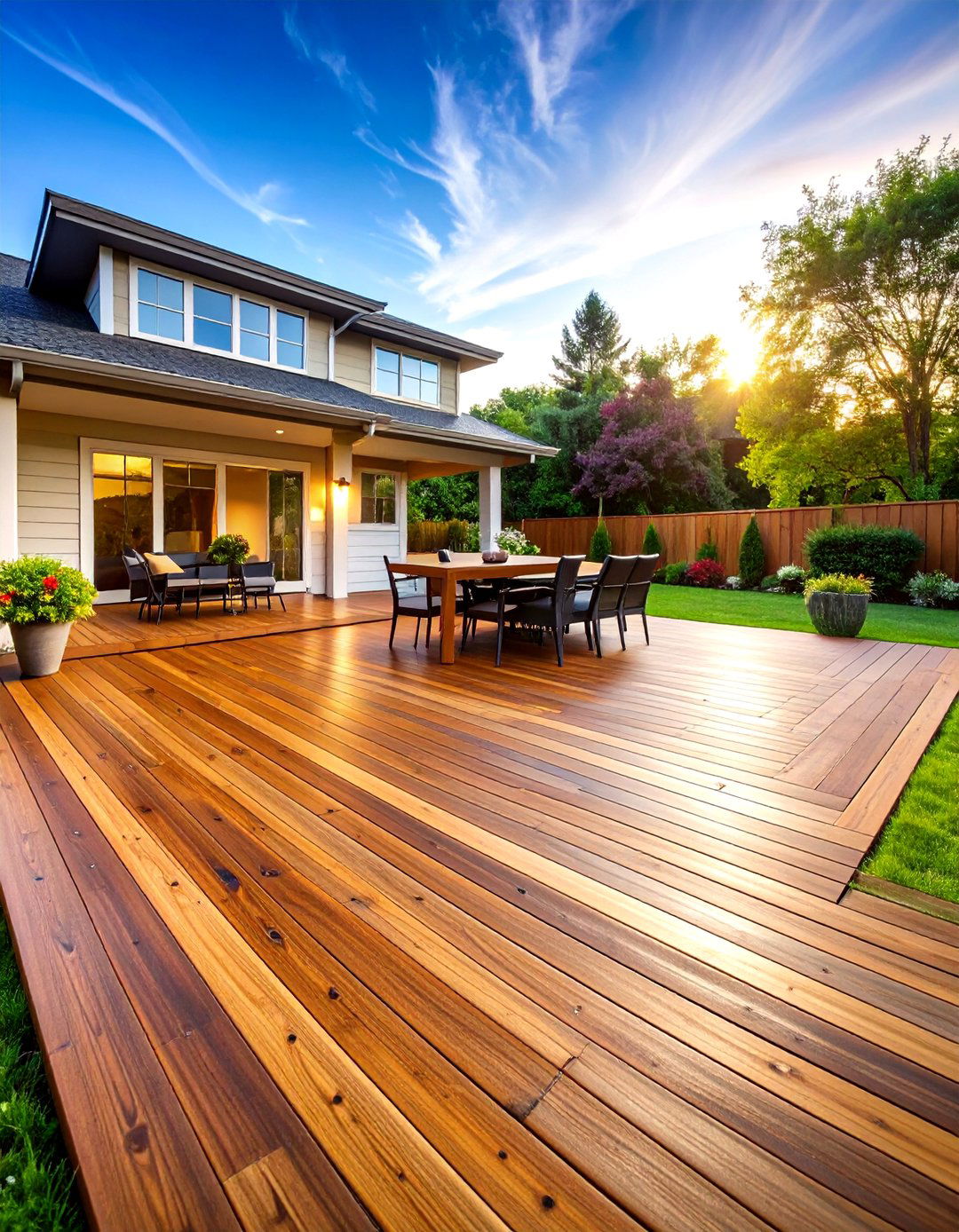
A sun-warmed stretch of pressure-treated lumber delivers classic deck flooring charm at a modest price, resisting pests and rot thanks to modern copper-based preservatives. Choose kiln-dried-after-treatment boards to reduce cracking, then add a penetrating semi-transparent stain that highlights natural grain while shedding water. Because this material is abundantly stocked in standard sizes, weekend DIYers can replace a board or two without hunting specialty suppliers. Annual washing and light sanding keep splinters at bay, and re-staining every couple of seasons refreshes color without heavy stripping. If you value authenticity, appreciate the smell of fresh-cut pine, and are comfortable with a bit of maintenance, this timeless surface remains a versatile, family-friendly foundation.
2. Composite Deck Flooring for Low-Maintenance Living
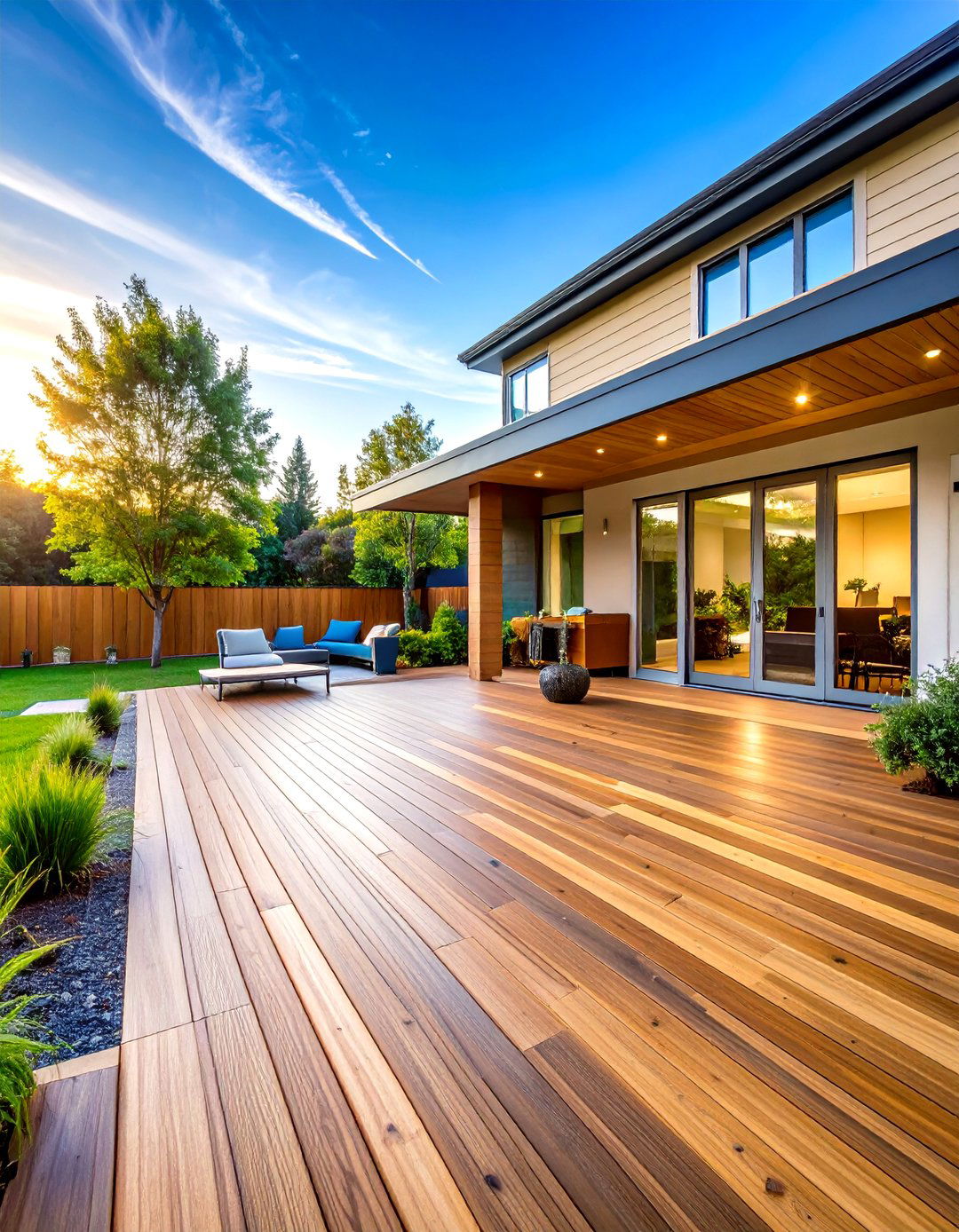
Unlike wood that begs for sanding and sealing, composite deck flooring blends recycled plastic with wood fibers, sealing color through every layer so scratches barely show. Hidden-clip fasteners create ultra-clean lines, and boards arrive in multiple widths, letting you pair narrow planks in conversation zones with chic, extra-wide boards along the perimeter. Many brands now carry cool-touch pigments and infrared-reflective additives, a relief for tender feet on scorching afternoons. Although the upfront cost rivals premium hardwood, long warranties and minimal upkeep often balance the ledger within a few seasons. If weekends are for friends— not refinishing—composite delivers the fade-resistant polish of indoor floors beneath open skies.
3. Eco-Friendly Bamboo Deck Tiles

For renters or indecisive remodelers, snap-together bamboo deck tiles offer an instant style upgrade that can move wherever life leads. The grass-based strips are heat-compressed with resin into dense slats, then mounted on polypropylene backing that drains rainwater while encouraging airflow beneath. Owing to bamboo’s rapid regrowth, many homeowners choose this deck flooring to shrink their carbon footprint without sacrificing warmth. A single afternoon transforms a tired concrete balcony into a spa-like escape, and damaged tiles pop out individually for replacement. Apply a UV-blocking oil twice a year to prevent silvering, and you’ll enjoy a sustainable surface that blends tropical aesthetics with remodeling flexibility.
4. Luxurious Ipe Hardwood Deck Boards
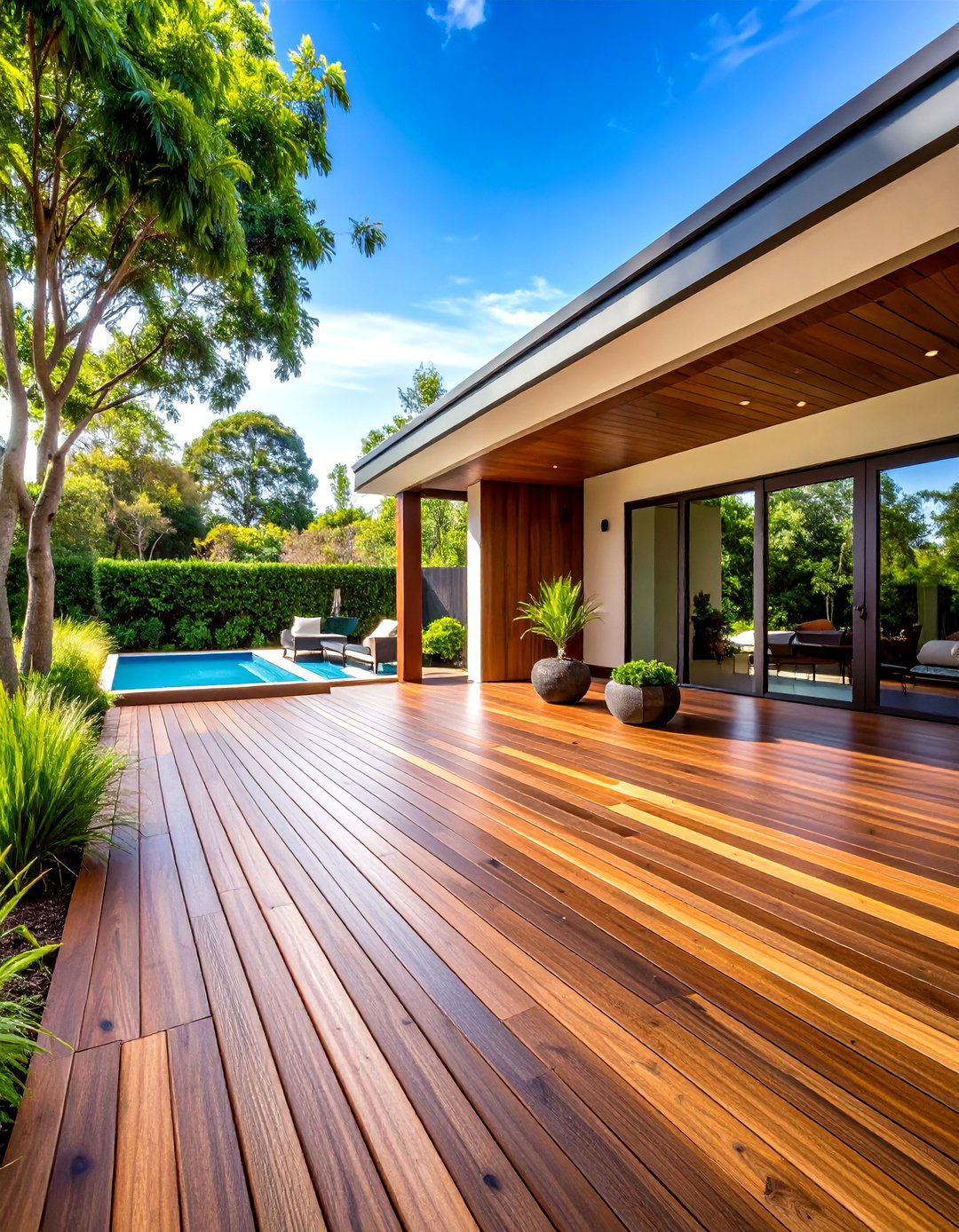
Certainly, few deck flooring materials rival Ipe for sheer indulgent presence. Harvested under strict forestry certifications, this South American hardwood registers nearly twice the hardness of oak, shrugging off dents, insects, and coastal salt spray. Its deep chocolate tone can be preserved with a penetrating oil or allowed to mellow into a driftwood gray that suits seaside schemes. Pre-drilling and using stainless steel screws tame its density, while hidden-clip grooves simplify board spacing. Though initial costs are steep and installation demands sharper blades, Ipe’s half-century lifespan makes it an heirloom surface. Choose it when you crave artisanal craftsmanship and trust that beauty built today will greet future generations.
5. Porcelain Paver Deck Panels
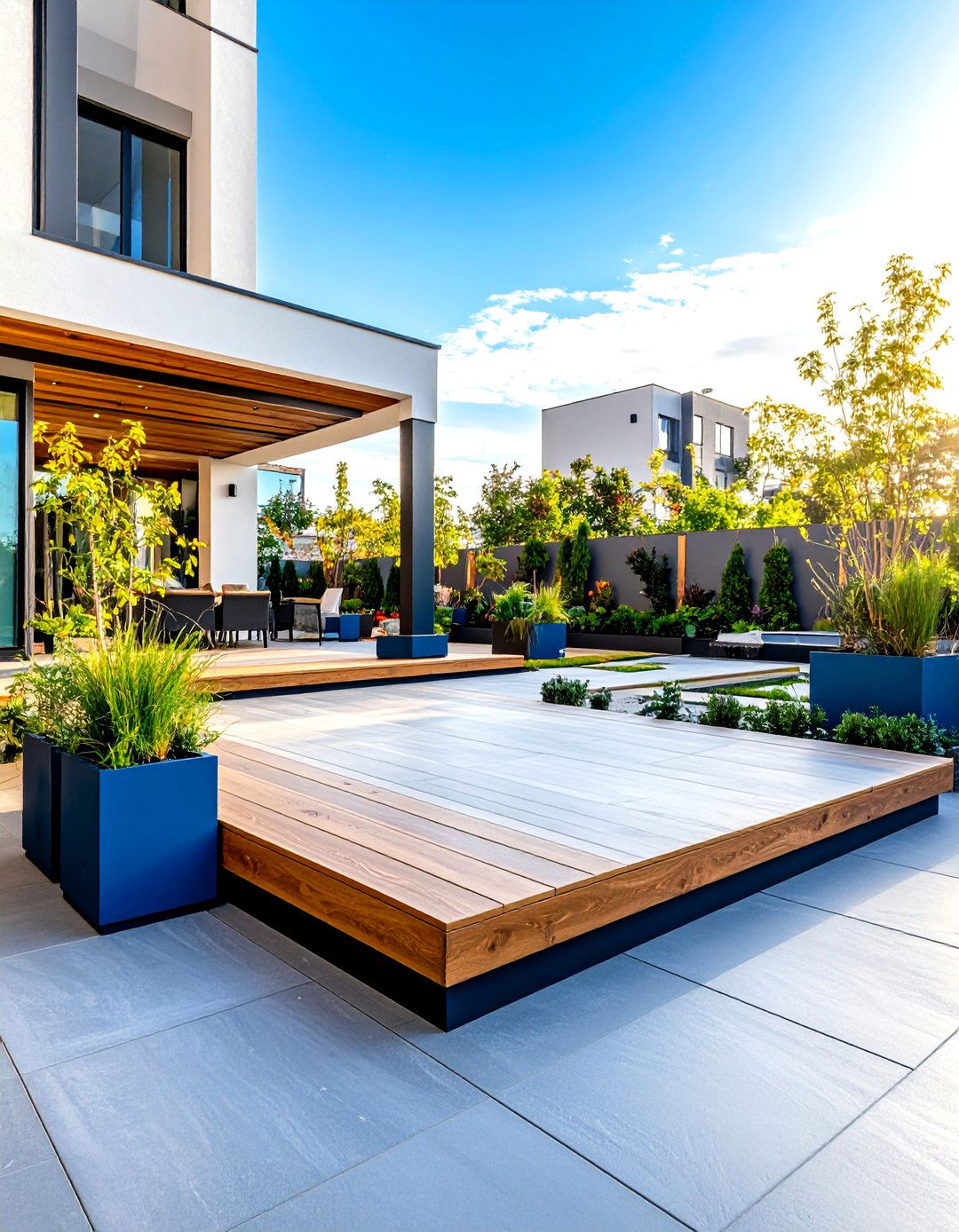
Surprisingly, porcelain—long trusted in kitchens—now moonlights outdoors as large-format deck flooring. Manufactured at high pressures and temperatures, these 20-millimeter-thick pavers resist staining, frost, pool chemicals, and barbecue grease with equal poise. They perch on adjustable pedestal systems, hiding wires, irrigation lines, or rooftop membranes underneath while creating perfectly level walking planes. Finishes mimic slate, wood grain, or concrete, so you can coordinate pool coping, planter walls, and deck boards in one material family. Periodic sweeping and the occasional soapy rinse suffice for upkeep, and color-through body construction means chips are barely visible. For urban terraces craving luxury without load-bearing headaches, porcelain pavers answer brilliantly.
6. Stained Concrete Deck Flooring in Bold Hues
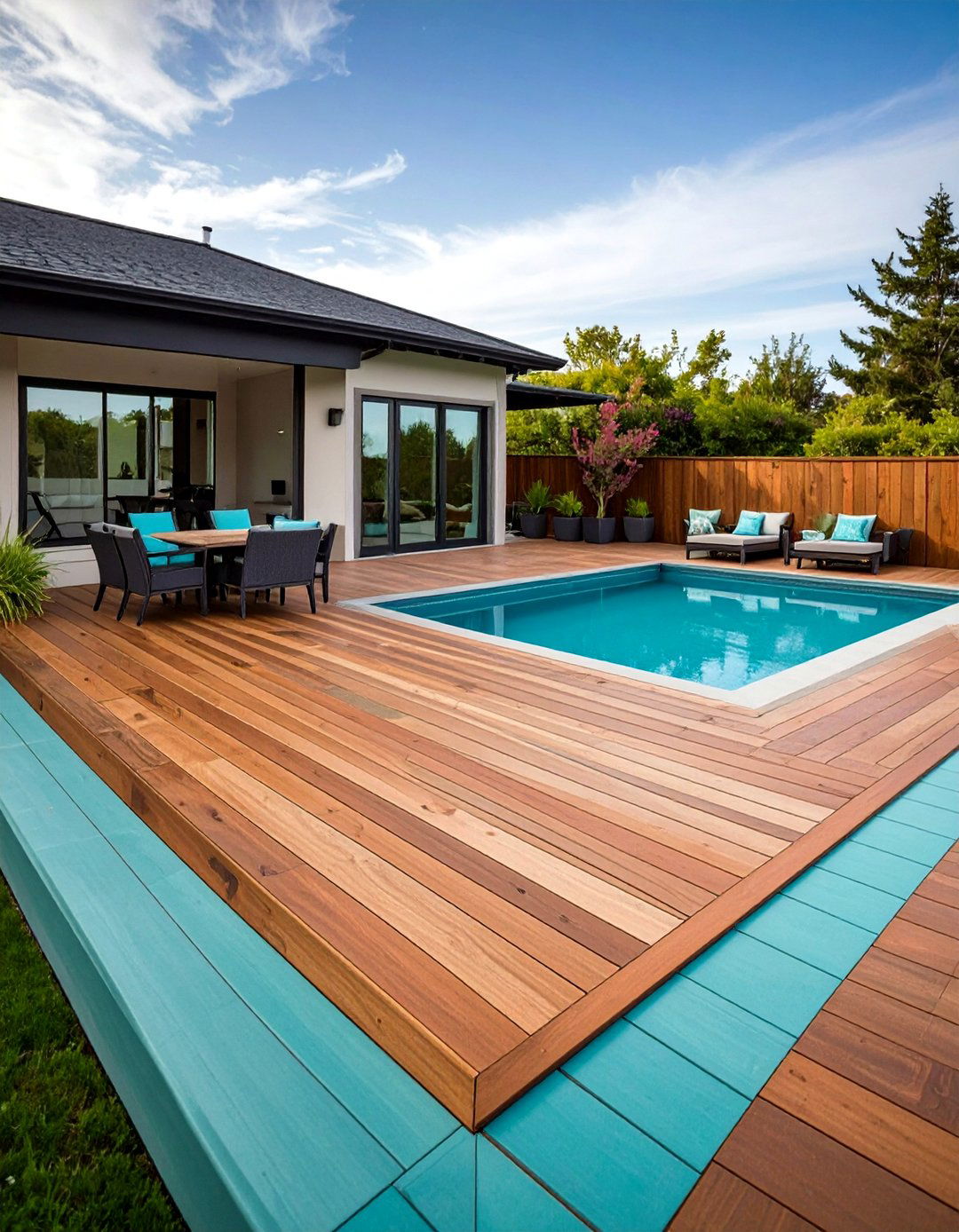
Looking to blur patio and deck zones? A richly stained concrete deck floor offers color possibilities beyond traditional browns and grays—think seaside teal, terracotta blush, or charcoal washed in pearl highlights. Acid-based stains etch subtle marbling, while water-based formulas deposit more uniform tones that won’t peel like paint. Add a slip-resistant acrylic sealer to keep shoes surefooted after rain and to protect pigment from UV fade. Expansion joints can be scored into geometric patterns that read like oversize tiles, delivering architectural flair for a fraction of porcelain’s cost. If your deck sits on a sturdy slab, staining creates a seamless, low-profile surface that pairs beautifully with contemporary furniture.
7. Interlocking Deck Tiles for Instant Makeovers
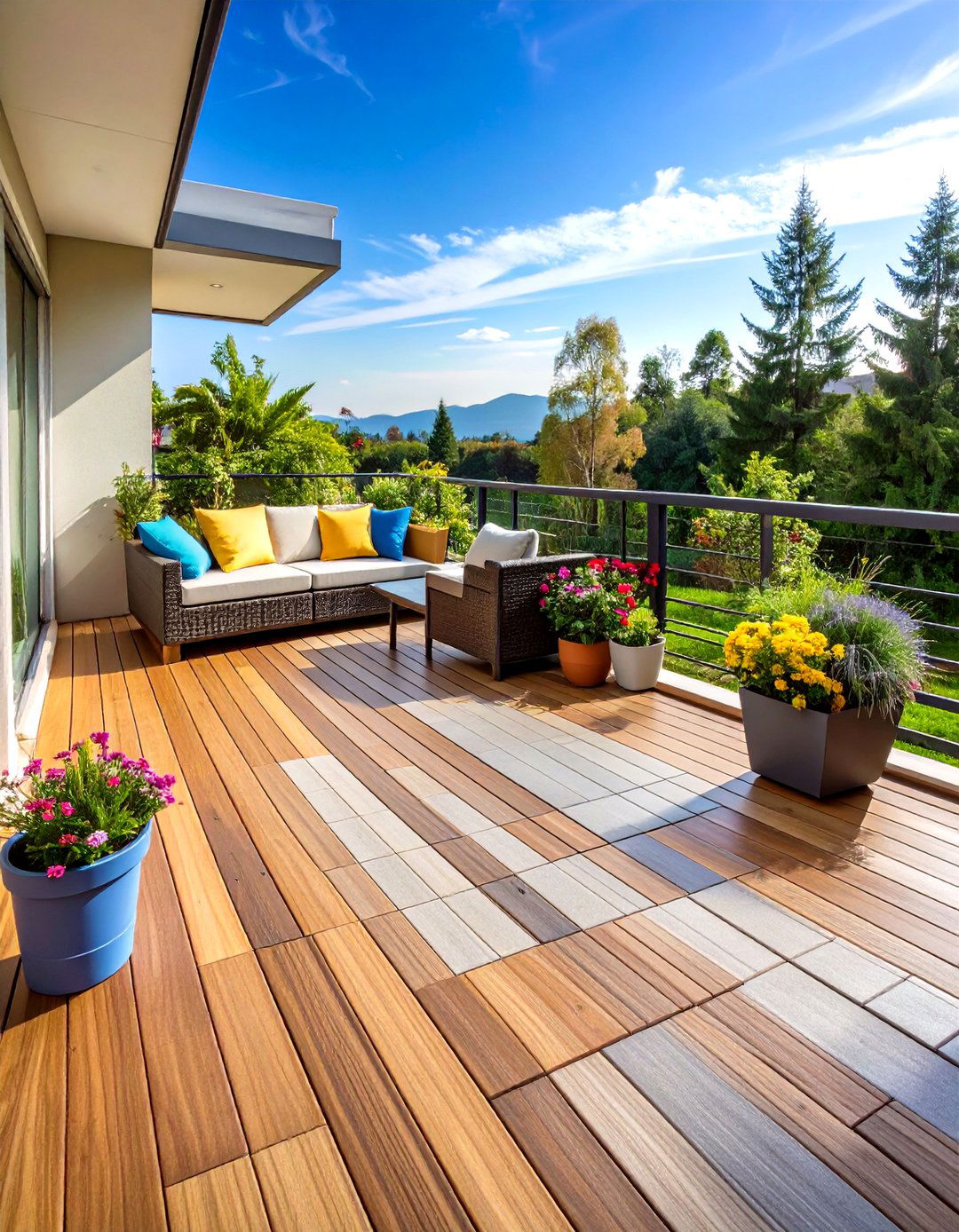
For condo balconies with tedious HOA rules, interlocking polypropylene deck tiles deliver a weekend-friendly facelift without nails, glue, or permits. Their vented profile drains fast, preventing puddles beneath outdoor rugs and workout mats. Colors range from stone-look neutrals to playful checkerboards, allowing quick patterns that boost curb appeal when units hit the market. The tiles flex slightly underfoot, softening hard concrete and insulating against heat in exposed sun tunnels. To clean, simply lift, hose below, and snap them back—no pressure washer required. If you anticipate rearranging furniture or relocating, these lightweight squares make deck flooring as modular as children’s building blocks.
8. Coastal-Tough PVC Decking

By resisting salt, sunscreen, and relentless UV rays, cellular PVC deck flooring dominates seaside builds and splash-happy pool surrounds. The boards are 100 percent plastic, so there’s no organic content for mold to munch, and color runs through the full thickness, making deep scratches less alarming. Textured, wood-grain embossing improves traction when feet drip from the water, and many lines meet Class-A fire ratings, easing hillside code compliance. Because boards are lighter than composites, framing labor drops, and long spans reduce joist quantity. Should a rogue wave or icy winter warp a plank, replacement is as simple as reversing hidden screws. Choose PVC when coastal climate tests every surface mercilessly.
9. Reclaimed Timber Deck Planks

Looking to infuse history into your backyard narrative? Reclaimed barn siding and factory beams can be milled into deck flooring that showcases nail holes, mineral streaks, and century-old tight grain you can’t buy new. Kiln sterilization removes insects, and grading services sort boards for structural integrity. Seal the surface with a breathable oil to emphasize patina without creating a glassy sheen that feels counterfeit. Because board lengths vary, a random-width layout saves waste and underscores authenticity. Expect occasional checks and movement—each imperfection tells a story—and plan on periodic oiling to refresh color. For homeowners committed to sustainability and character, reclaimed wood turns a deck into living heritage.
10. Outdoor Carpet Over Decking

For families craving barefoot softness or toddlers learning to toddle, marine-grade outdoor carpet transforms deck flooring into a plush lounge. Modern polypropylene fibers shrug off rain and UV rays while molded backing allows water to drain, preventing squishy surprises after storms. Choose peel-and-stick tiles for creative color blocking or broadloom rolls for uninterrupted texture. Vacuuming removes pollen, and an annual mild detergent scrub keeps fibers fresh. Pair with throw pillows and a low coffee table, and you’ve essentially stitched a living room under the stars. If acoustics matter—think upstairs terrace over a bedroom—the carpet’s sound-damping quality adds another layer of everyday comfort.
11. Artificial Turf Inserts Between Deck Boards
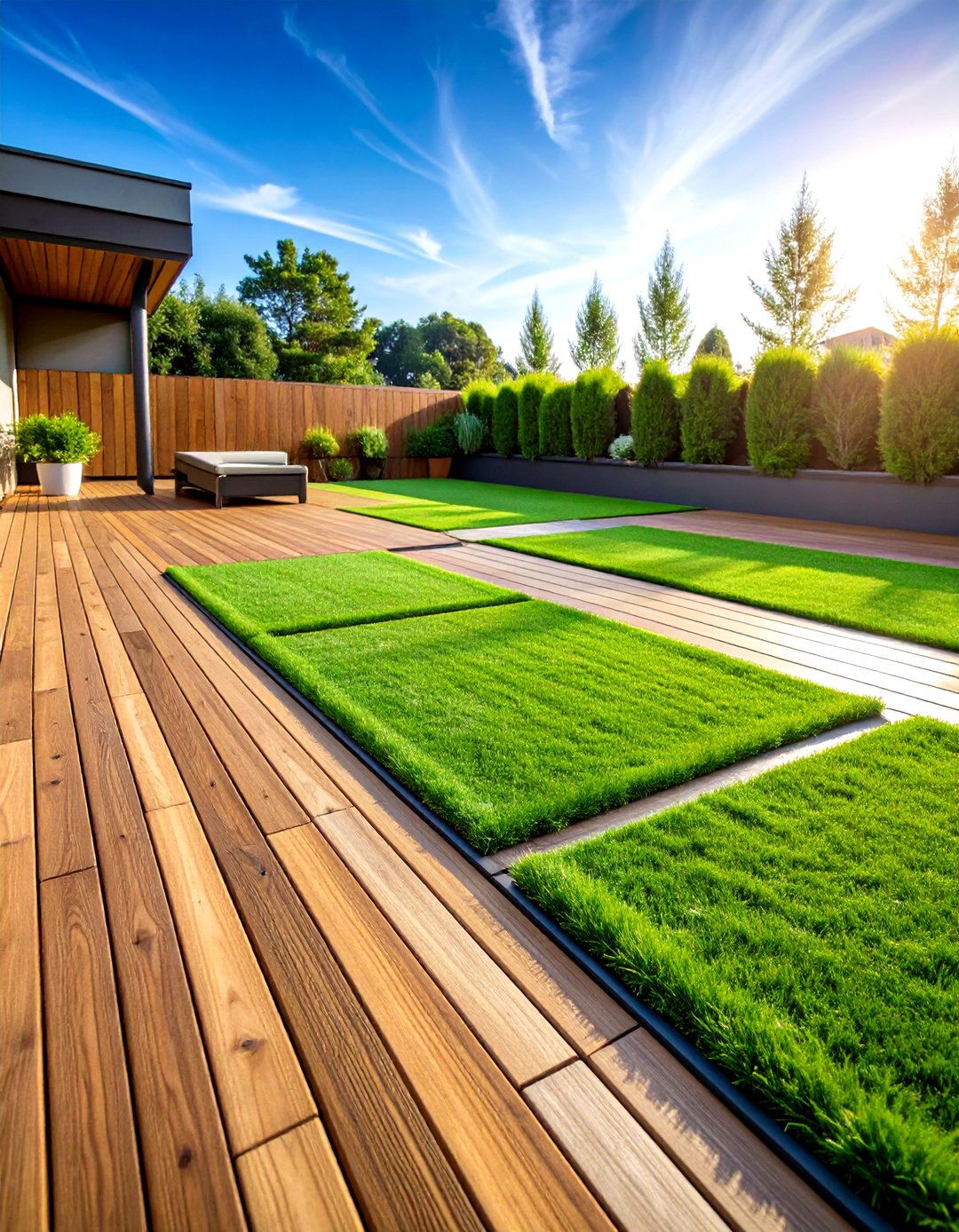
Another inventive twist pairs traditional decking with ribbons of artificial turf, turning deck flooring into a garden-meets-gathering field. Synthetic grass panels fit snugly between wide joists or within framed planter wells, delivering greenery where real sod would parch. Permeable backing drains rainwater, while antimicrobial infill keeps odors at bay despite pets and pool splashes. The contrast of warm timber beside vibrant blades visually zones lounging versus pathway areas without railings or level changes. Maintenance is as easy as brushing upright and hosing occasionally to remove dust. For entertainment-centric decks where kids or dogs crave soft play zones, turf inserts offer a worry-free mini-lawn in every season.
12. Mixed-Material Deck Flooring Patterns
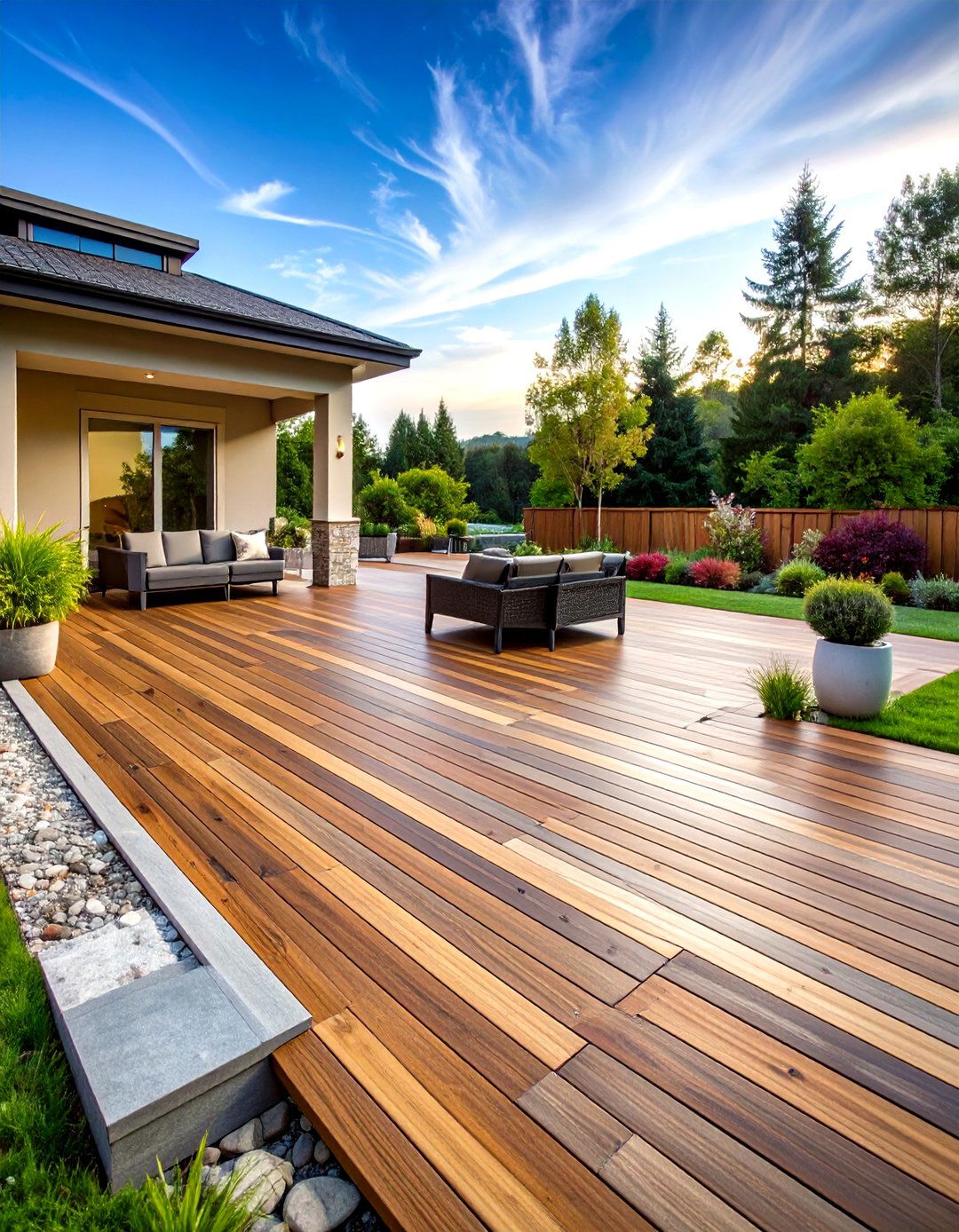
Owing to today’s wide palette of board widths, colors, and inlays, mixed-material deck flooring lets you treat a flat plane like a woven textile. Picture composite planks in weathered gray forming the field, trimmed by a darker picture frame of PVC, then punctuated with stone insets beneath a fire table. Metal-edge strips hide transitions and accommodate thermal movement. Beyond aesthetics, mixing materials solves practical puzzles: tile withstands hot grill legs, rubber cushions exercise corners, and drainage panels speed meltwater off snowy edges. By blending textures intentionally, you tailor performance to activity zones while crafting a one-of-a-kind conversation starter underfoot.
13. Herringbone Deck Board Layouts
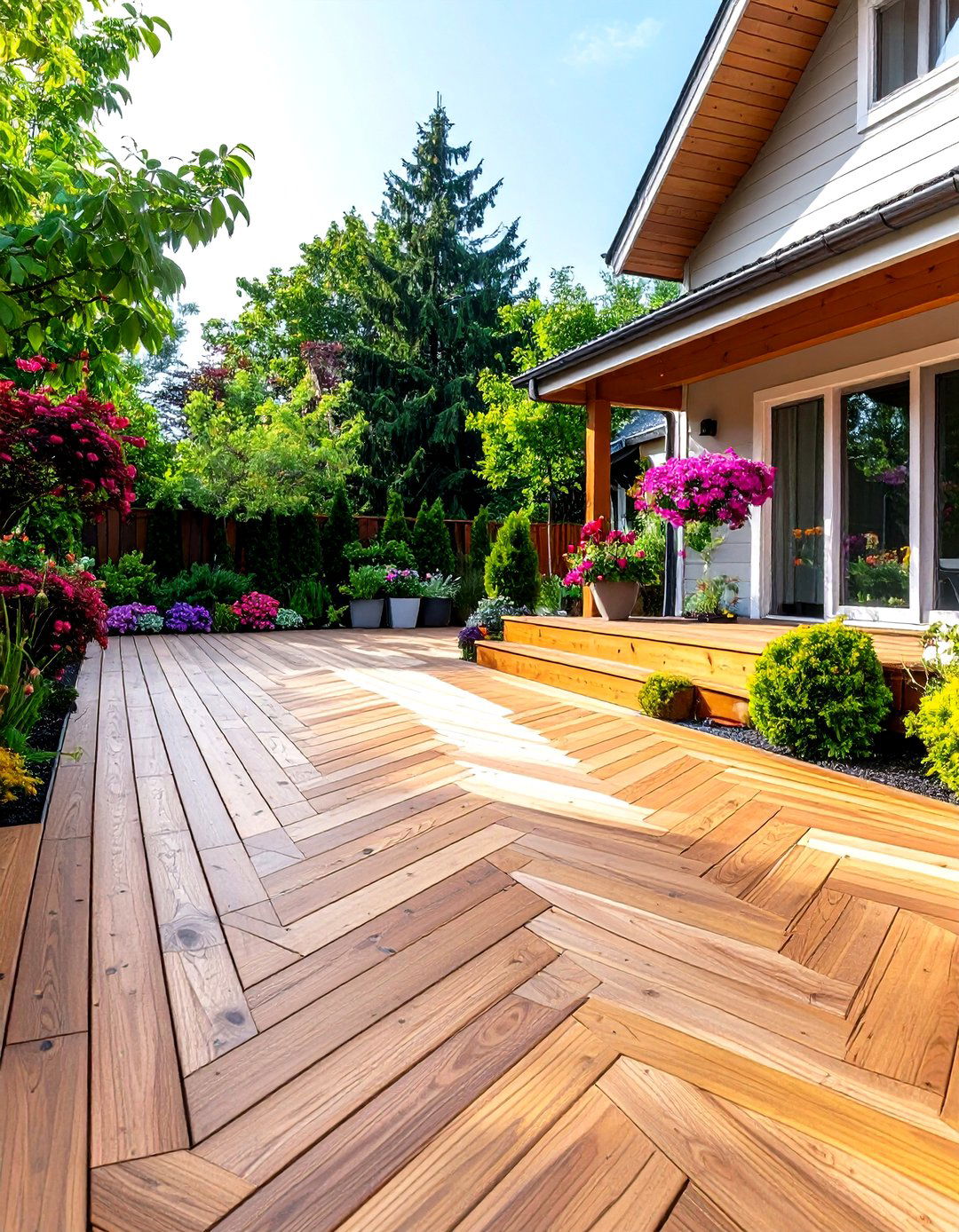
Unlike standard parallel runs, a herringbone pattern aims deck boards at forty-five-degree angles that meet in crisp chevrons—a classic flooring motif now trending al fresco. The design disperses movement stresses across joists, reducing cupping and providing satisfying visual rhythm that draws eyes toward focal points like French doors or a raised planter. Because cuts are precise, expect extra labor and roughly 15 percent more material, yet the payoff is sophisticated elegance usually reserved for parquet foyers. Choose single-color composite for subtlety or alternate hues for bold definition. When you desire geometry that feels intentional rather than busy, herringbone elevates small or large decks alike.
14. Curved Deck Board Installations

With advanced heat-forming blankets, installers now coax composite or PVC deck flooring into gentle arcs that echo pool lines, garden paths, or architectural bays. Curved perimeters eliminate hard corners, encouraging relaxed foot traffic and creating inviting nooks for circular seating. Underneath, double-joist blocking and flexible rim joists maintain support, while fascia made from the same bent boards finishes edges seamlessly. Although curving adds cost and requires specialized crews, it transforms a predictable rectangle into an organic flow that mirrors landscapes. If you want a deck that whispers resort chic and maximizes panoramic views, embracing curves can turn ordinary edges into artful horizons.
15. LED-Integrated Deck Boards for Nighttime Ambiance
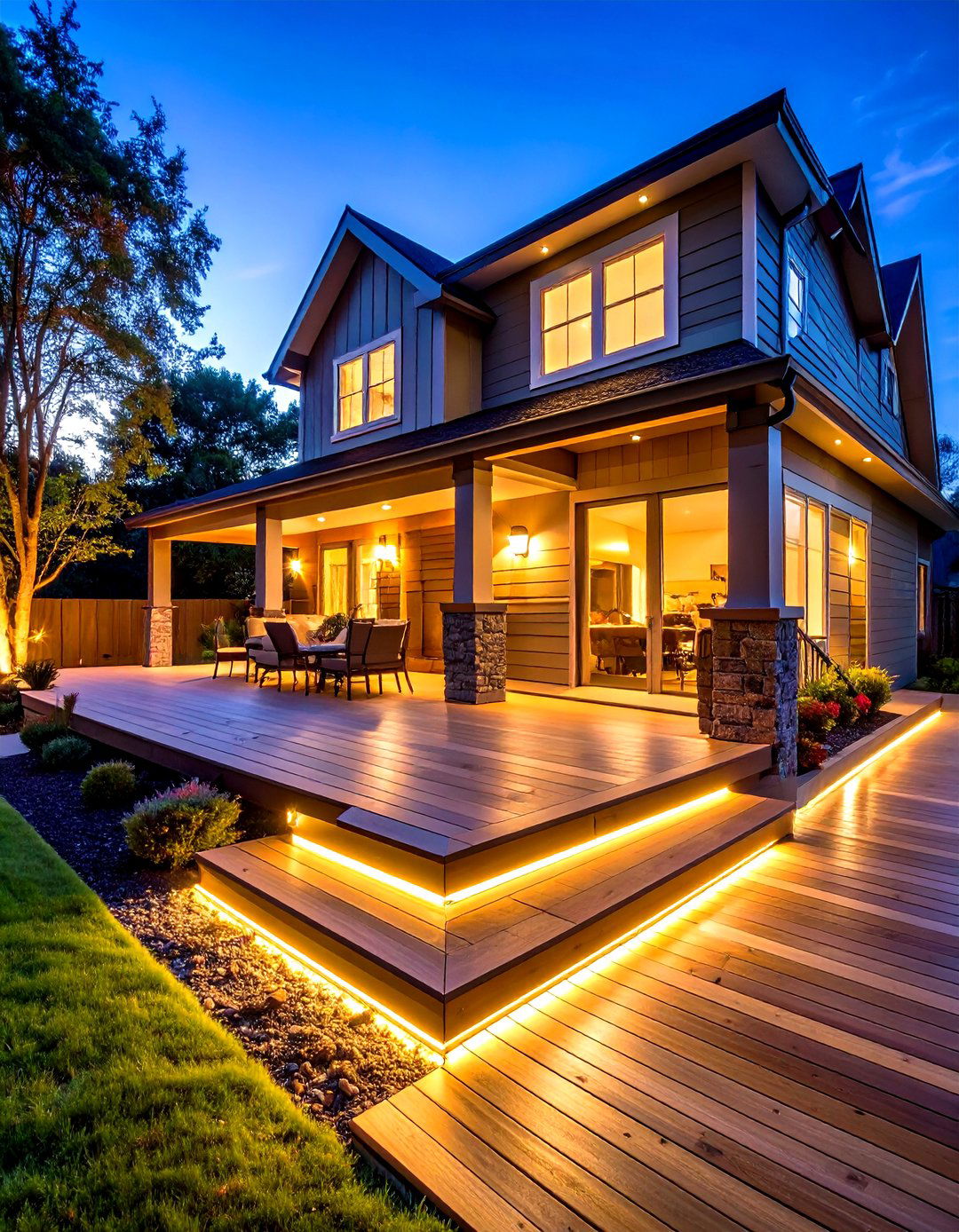
When dusk settles, LED-ready deck flooring keeps conversations glowing without tripping hazards. Many composite systems now include pre-routed channels that accept low-voltage light strips, tucking wires safely beneath boards and connecting to dimmable smart transformers. Warm white lines along stair nosings, perimeter picture frames, or even every fifth board create subtle runway guidance that flatters evening gatherings. Energy consumption stays minimal, and app controls let you shift scenes from cozy amber to playful color cycles during celebrations. If you host after-dark dinners or simply enjoy stargazing, built-in lighting turns the floor itself into a welcoming, design-forward illumination feature.
16. Weathered Gray Finish Decking
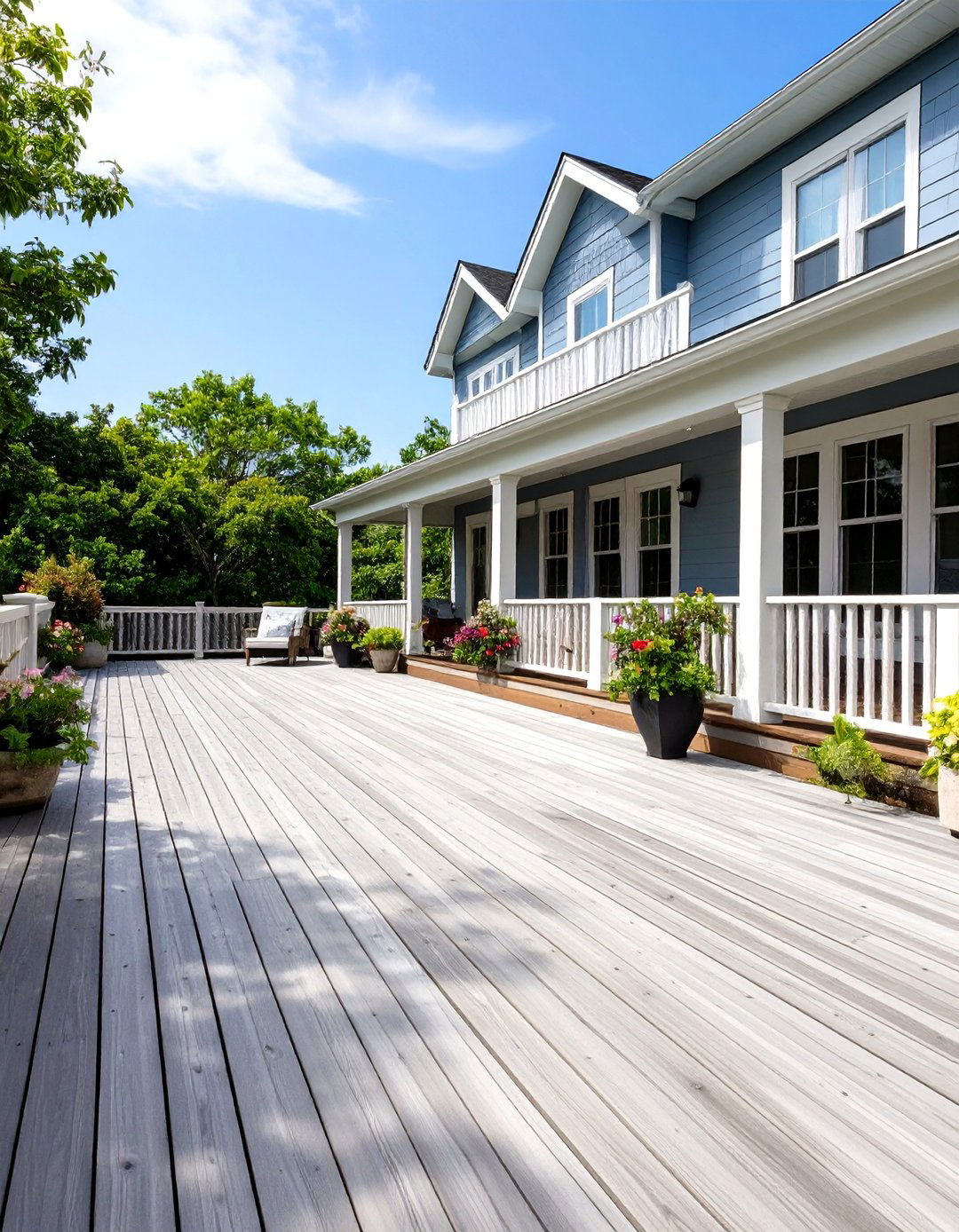
For homeowners chasing a windswept coastal vibe—without waiting years—factory-finished weathered gray deck flooring delivers instant patina. These composite and modified-wood boards arrive with variegated hues mimicking sun-bleached cedar, so color remains consistent across repairs. Installation is identical to standard decking, but the appearance suggests decades of gentle aging. Pair with black cable rail for a modern nautical aesthetic, or add white Adirondack chairs for cottage charm. Because the gray tone hides pollen and dust better than darker browns, sweepings can be less frequent in windy climates. When your design vision leans serene and understated, pre-aged decking achieves relaxed elegance on day one.
17. Slip-Resistant Rubber Deck Surfaces
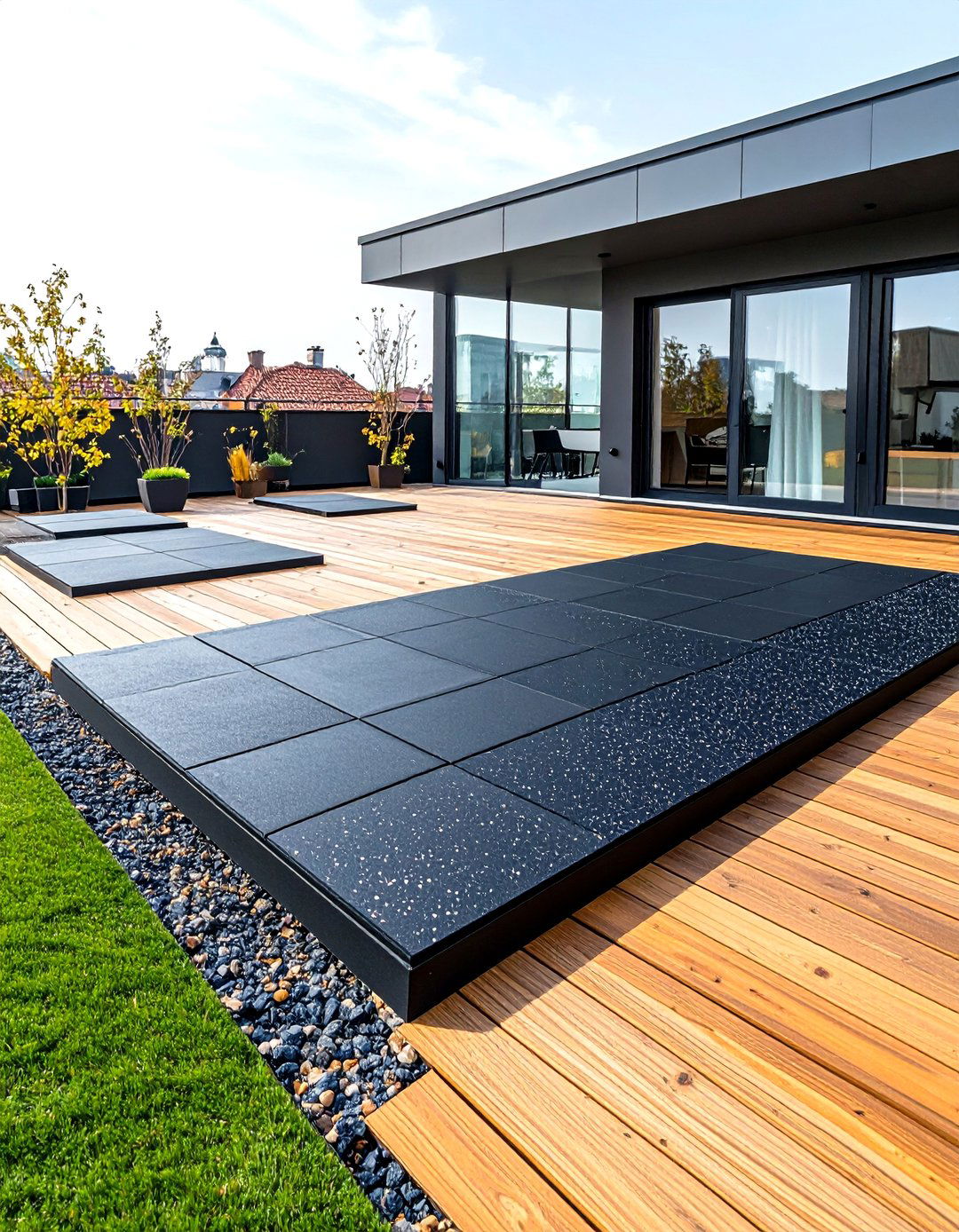
From rooftop gyms to waterside yoga platforms, slip-resistant rubber deck flooring protects joints while gripping shoes and bare feet alike. Tiles or rolled sheets made from recycled tires cushion impact and mute sound—handy for city neighbors or multi-family units. UV-stable coatings prevent chalking, and hidden-pin connectors lock pieces together without visible seams. While color palettes skew darker, speckled infusions add playful accents that mask scuffs. Cleaning calls for a broom and mild soap; no sealing required. If your deck doubles as an exercise studio, play area, or accessibility ramp, rubber surfacing supplies dependable traction and comfort without sacrificing weather tolerance.
18. Heated Deck Flooring for Cold Climates
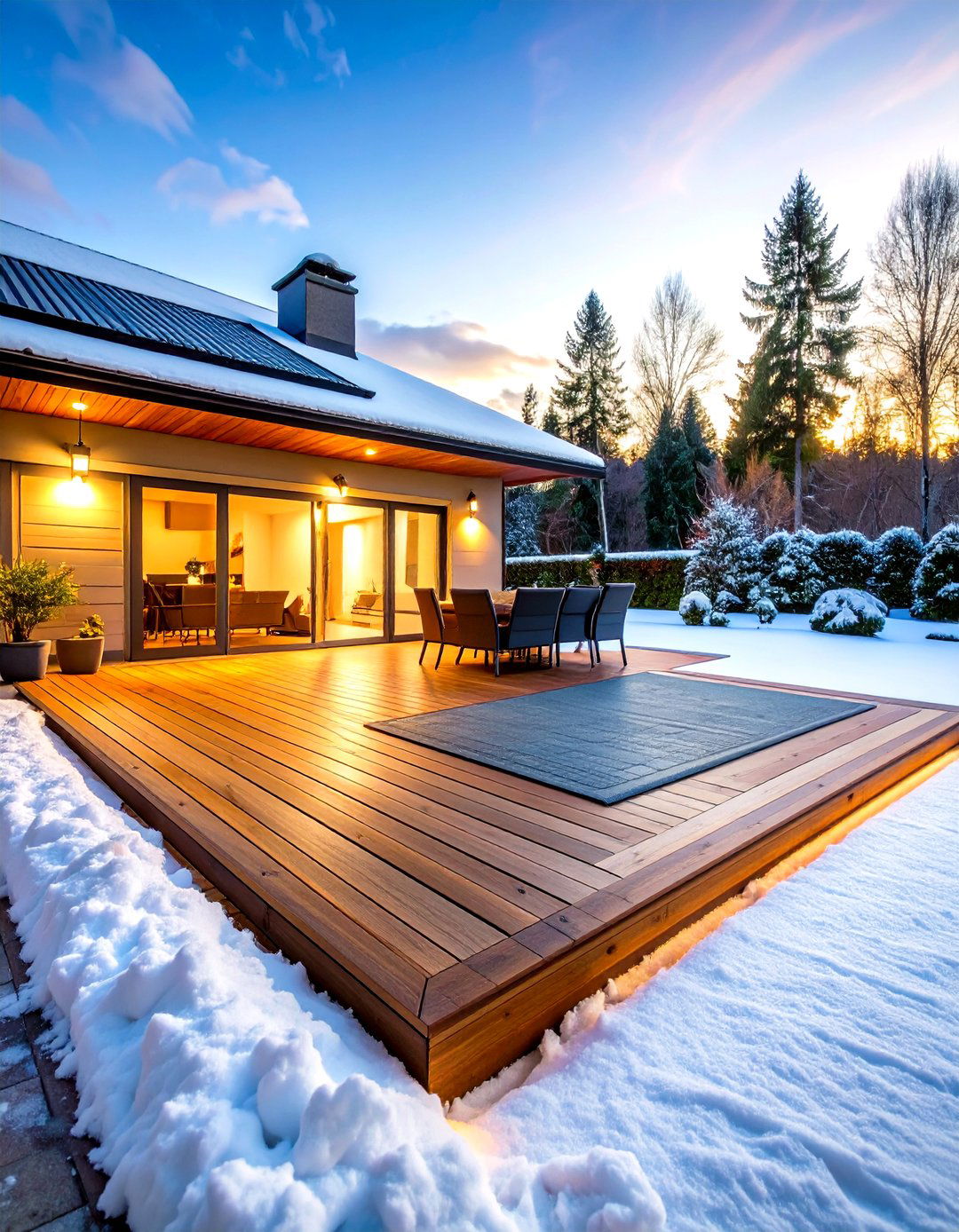
When snow turns steps icy, radiant-heated deck flooring quietly melts hazards before shovels emerge. Electric mats or hydronic tubes tuck beneath composite boards or embedded within concrete overlays, evenly warming surfaces above freezing. Outdoor-rated thermostats activate systems only when sensors detect moisture and low temperatures, keeping energy bills sensible. Heated zones near hot tubs or exterior doors minimize tracking slush indoors, extending deck utility deep into winter. Installation pairs best with new builds or major resurfacing, yet can retrofit beneath modular tiles. If you’re determined to sip cocoa under snowfall without slipping, built-in warmth converts your deck into a four-season haven.
19. Modular Aluminum Decking Systems

With interlocking planks that double as waterproof ceilings, modular aluminum decking creates dry storage beneath second-story platforms while defying rust. Powder-coated finishes mimic woodgrain or contemporary matte tones and stay cool thanks to high reflectivity. Because boards lock side-to-side with gasketed channels, rain drips harmlessly into a gutter, protecting patio furniture below. Spans reach fifteen feet, slashing joist lumber, and fire-resistant properties meet strict code in wildfire zones. Surface scratches reveal matching metal, not raw wood, so appearance ages gracefully. For homeowners installing under-deck kitchens or wanting zero maintenance in extreme climates, aluminum delivers pragmatic performance with sleek modern lines.
20. Painted Deck Floor Stencils and Graphics
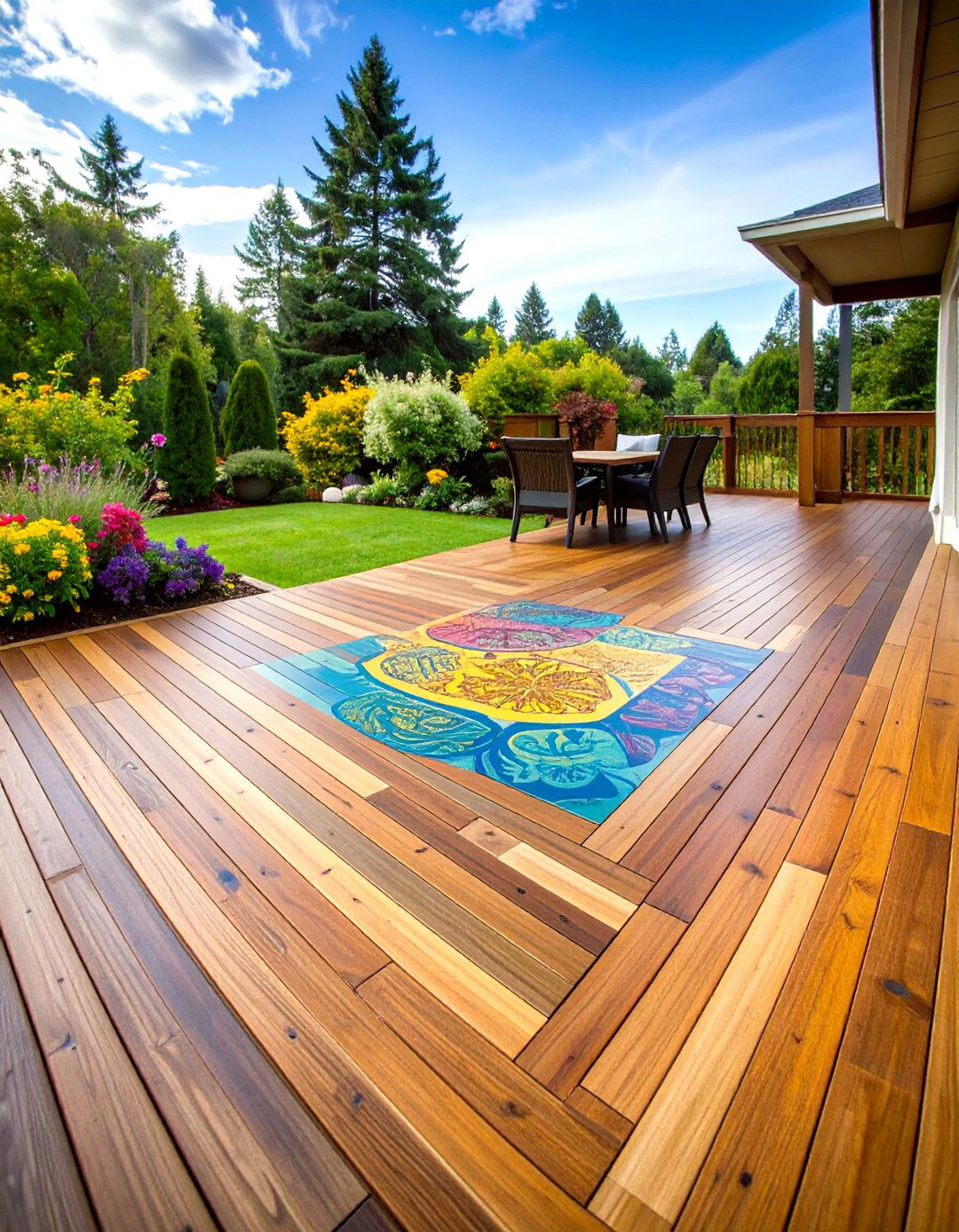
To wrap things up creatively, painted stencils turn humble deck flooring into an outdoor rug that never flaps in the wind. Start with a high-bonding porch paint, then overlay durable mylar patterns—medallions, Moroccan trellis, or contemporary stripes—rolling contrasting hues through cutouts. Two coats of clear, non-yellowing urethane protect artwork from traffic and UV; add anti-skid grit for safety. Because paint bridges hairline cracks and disguises mismatched repairs, it’s an economical refresh for aging surfaces awaiting future replacement. Change colors seasonally or coordinate with patio cushions for cohesive style without buying new furniture. This artistic flourish proves a deck can be both durable foundation and expressive canvas.
Conclusion:
Choosing the right deck flooring is less about chasing trends and more about matching lifestyle, climate, and maintenance comfort. From pressure-treated wood’s approachable warmth to aluminum’s engineer-level efficiency, every option carries unique strengths that shape how you gather, relax, and protect your investment. Factor in traffic patterns, regional weather, and desired ambiance, and you’ll quickly identify surfaces that feel intuitive underfoot while standing strong against the elements. Whether you lean toward eco-friendly bamboo, glow-infused LED boards, or graphics-rich paint, the possibilities outlined above empower you to craft an outdoor stage that celebrates everyday moments—and invites future memories to unfold with ease.


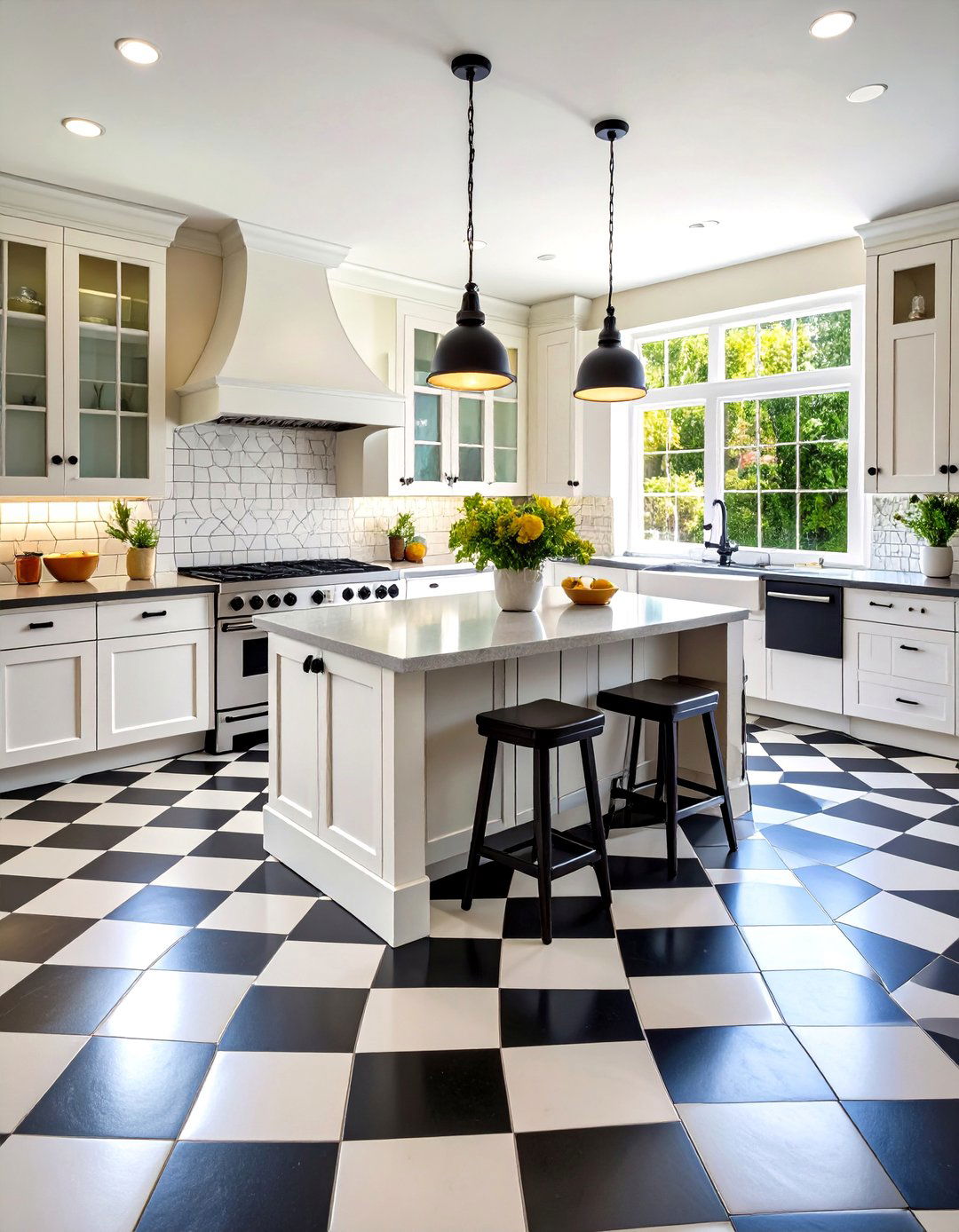

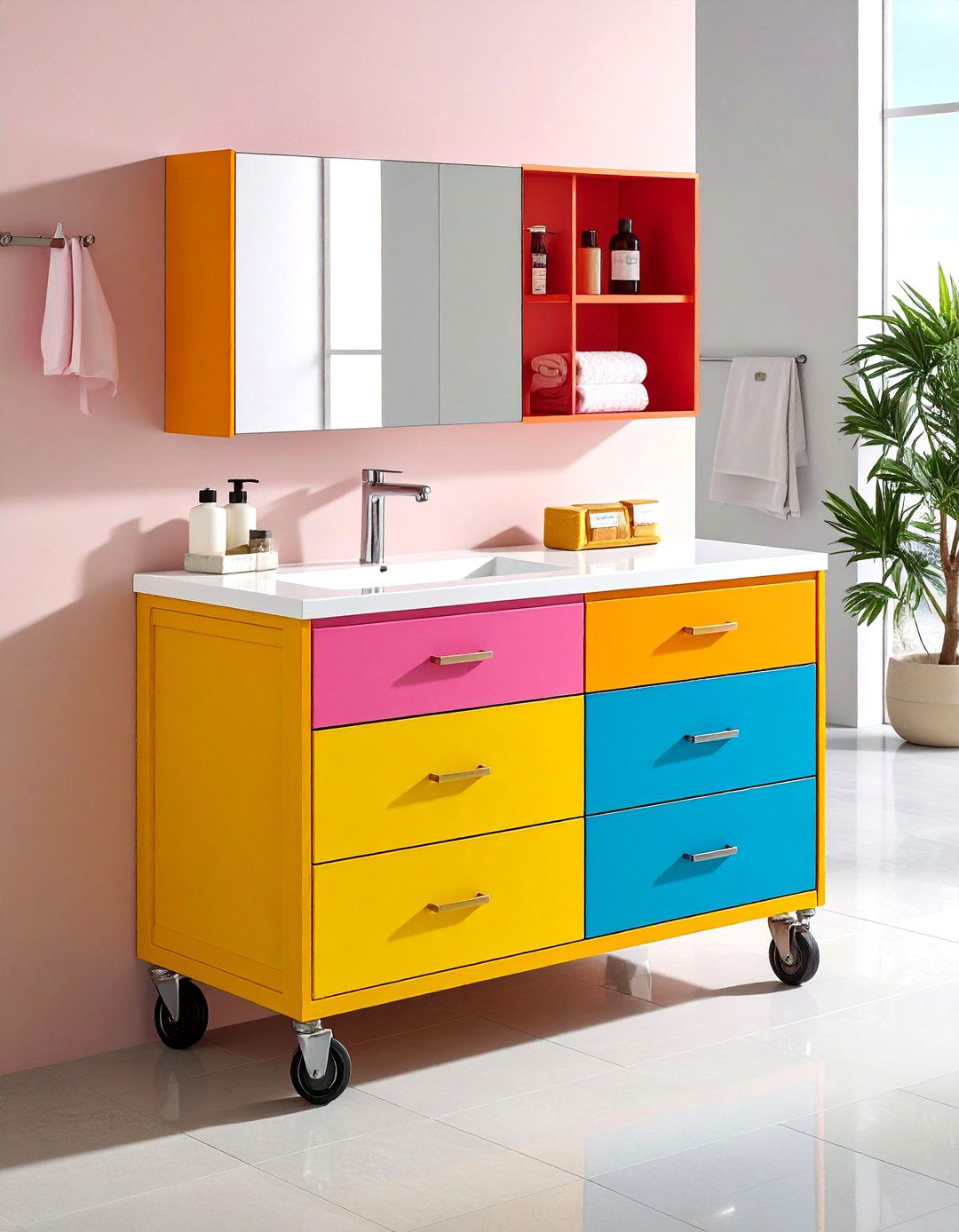
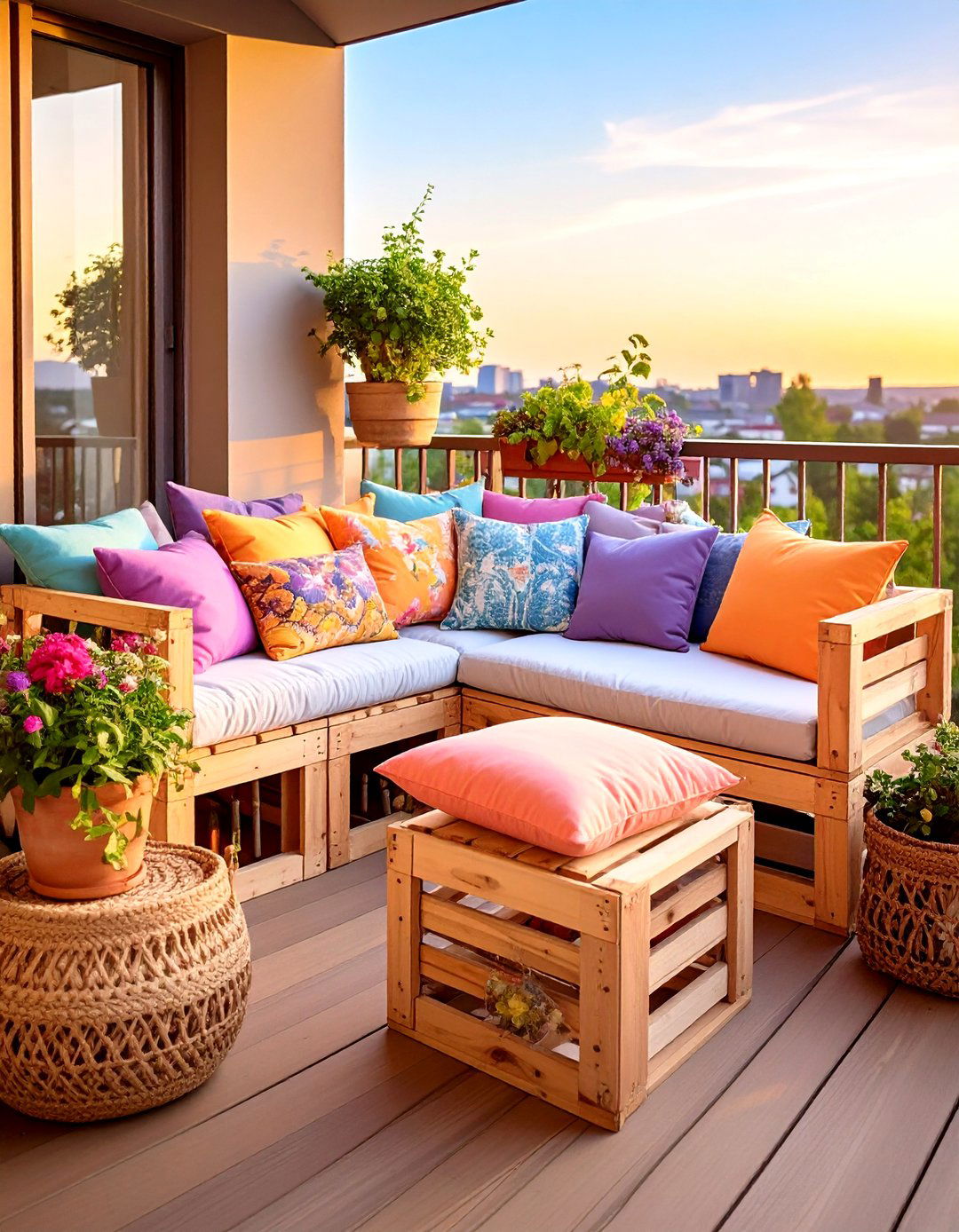
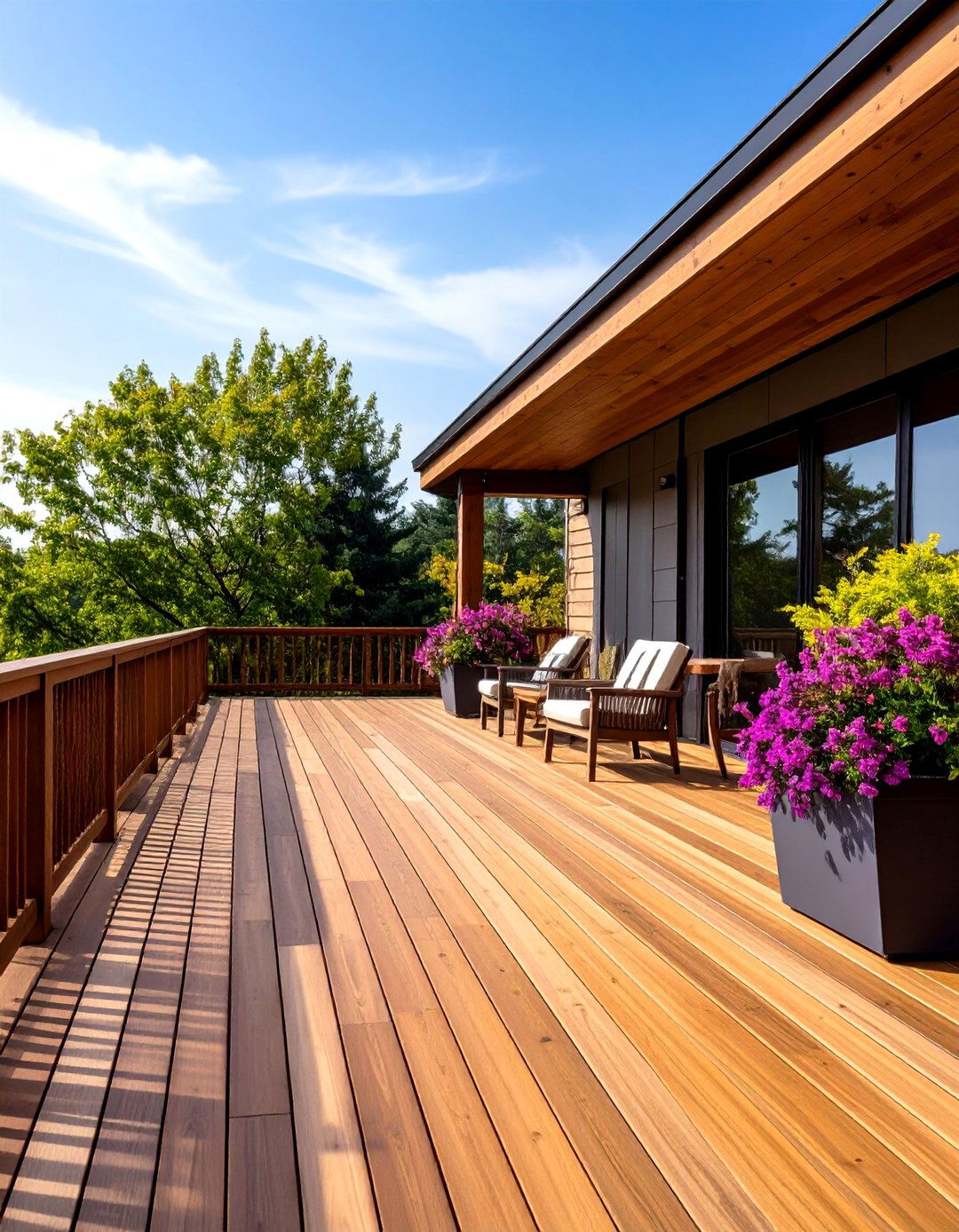
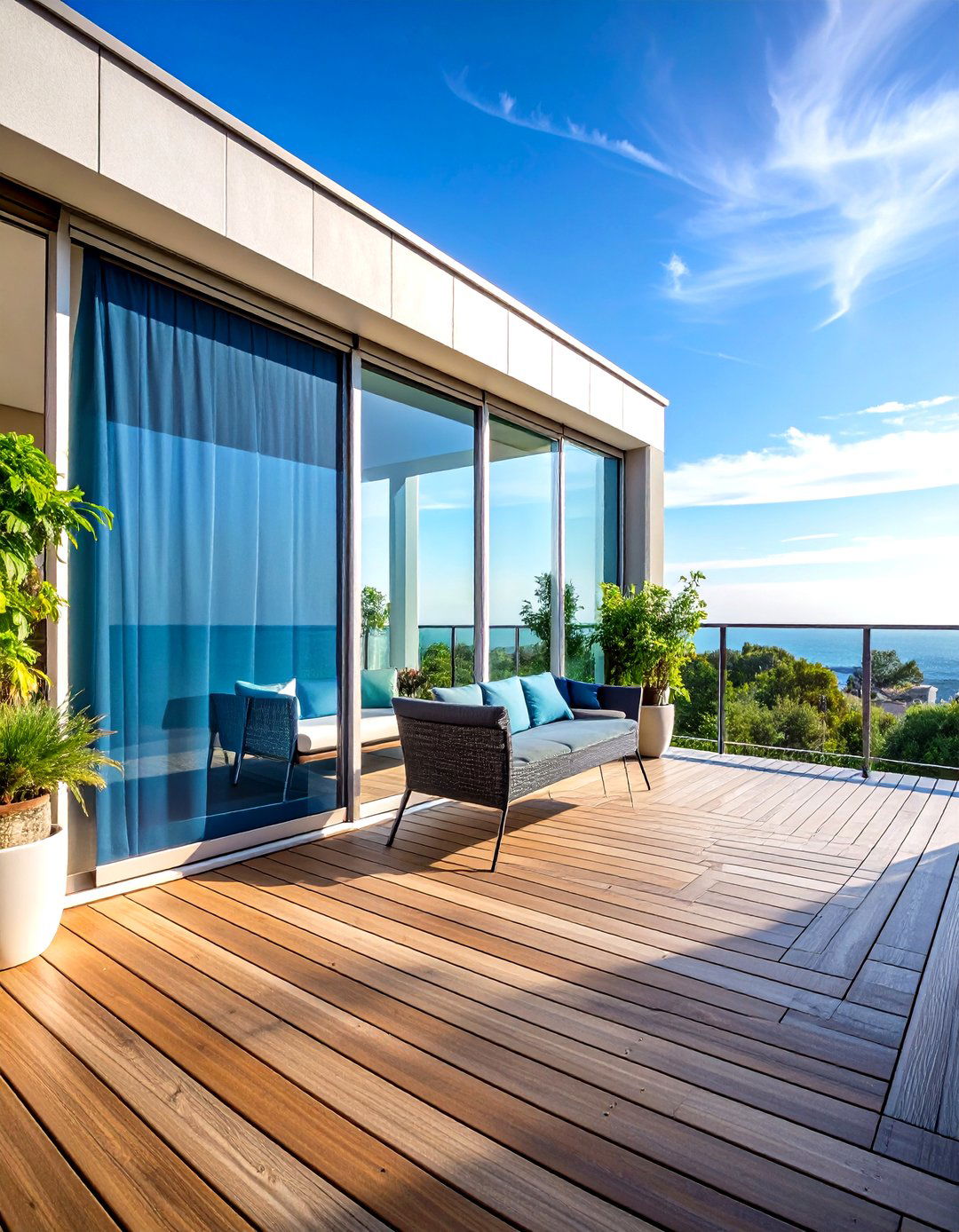
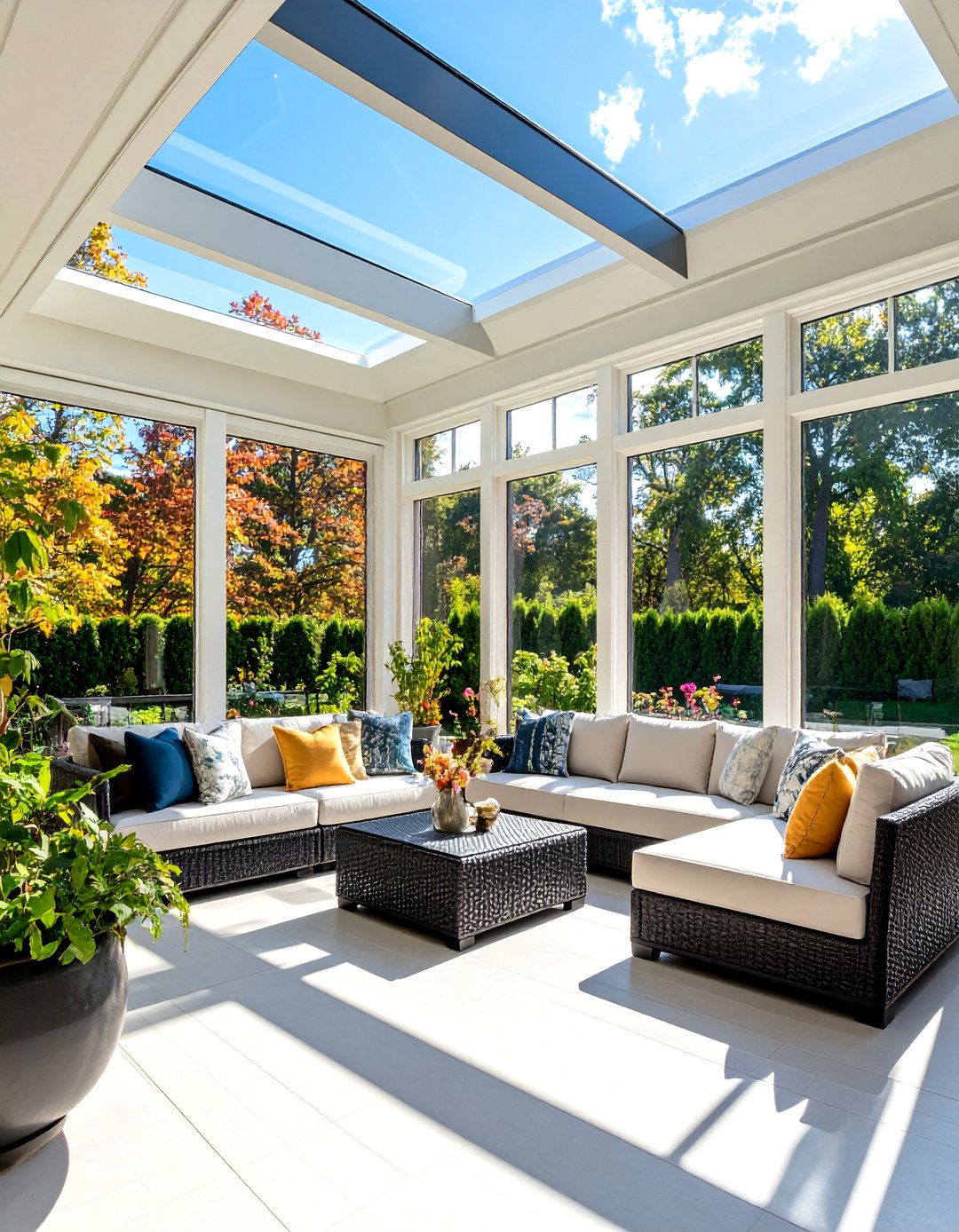
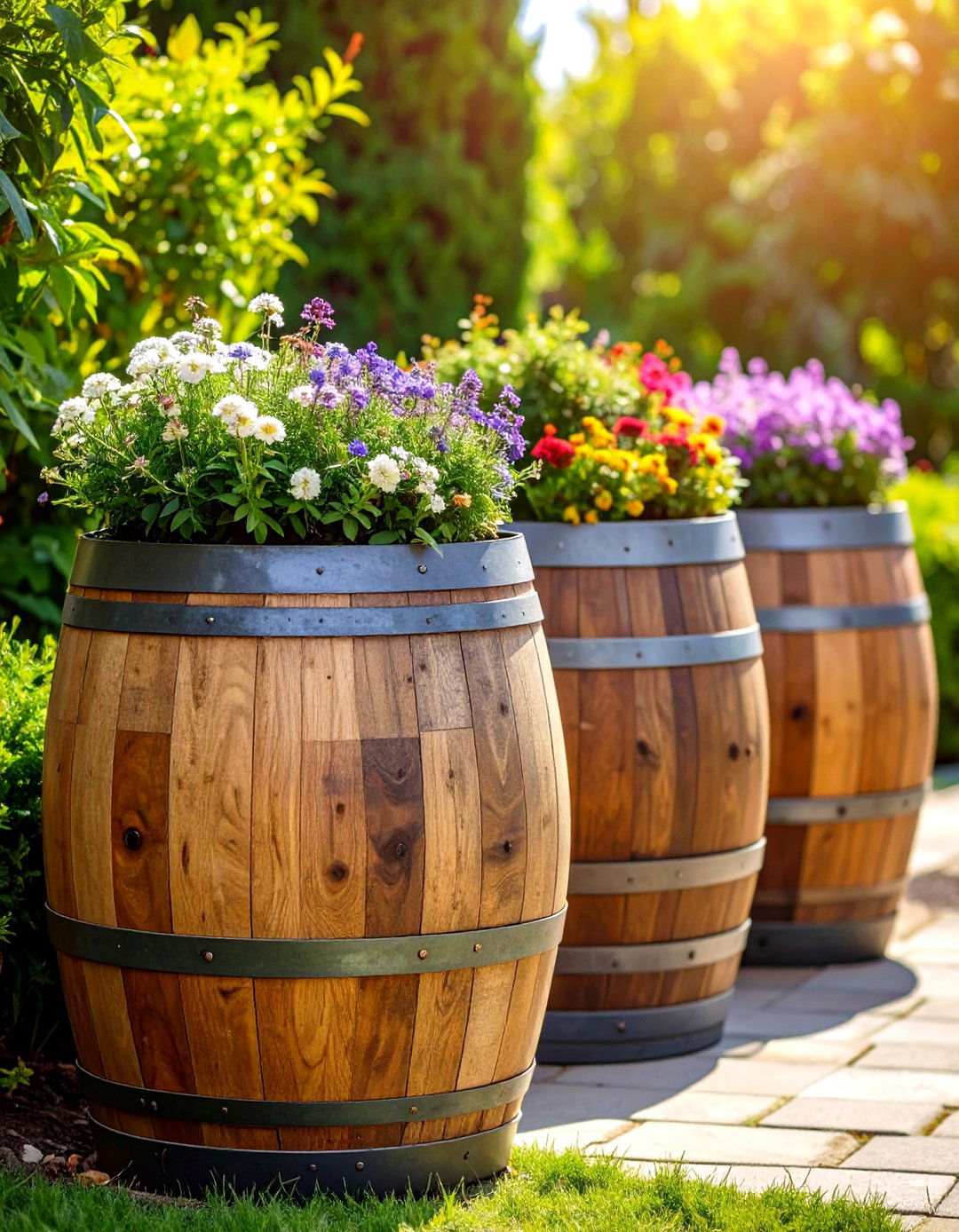
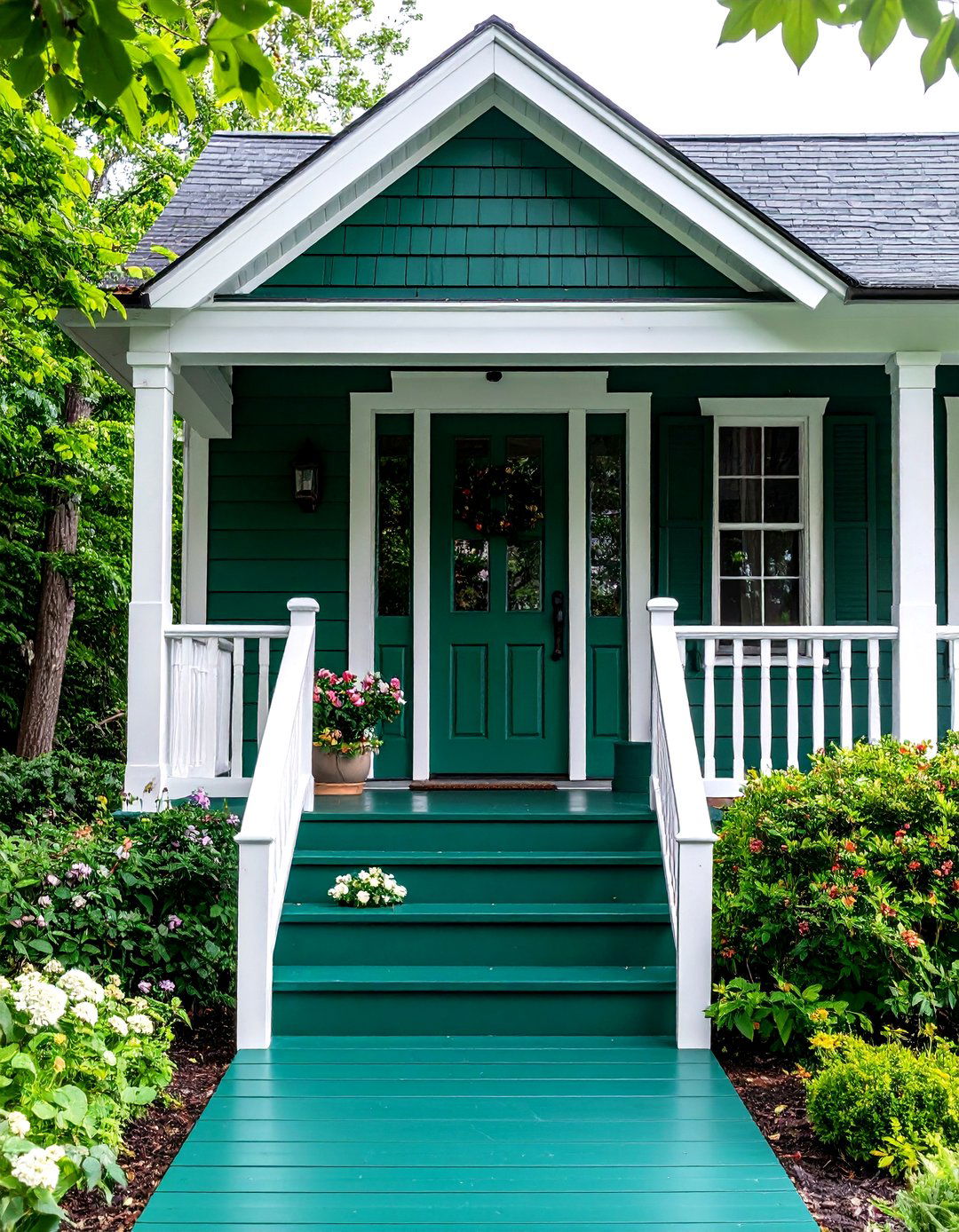
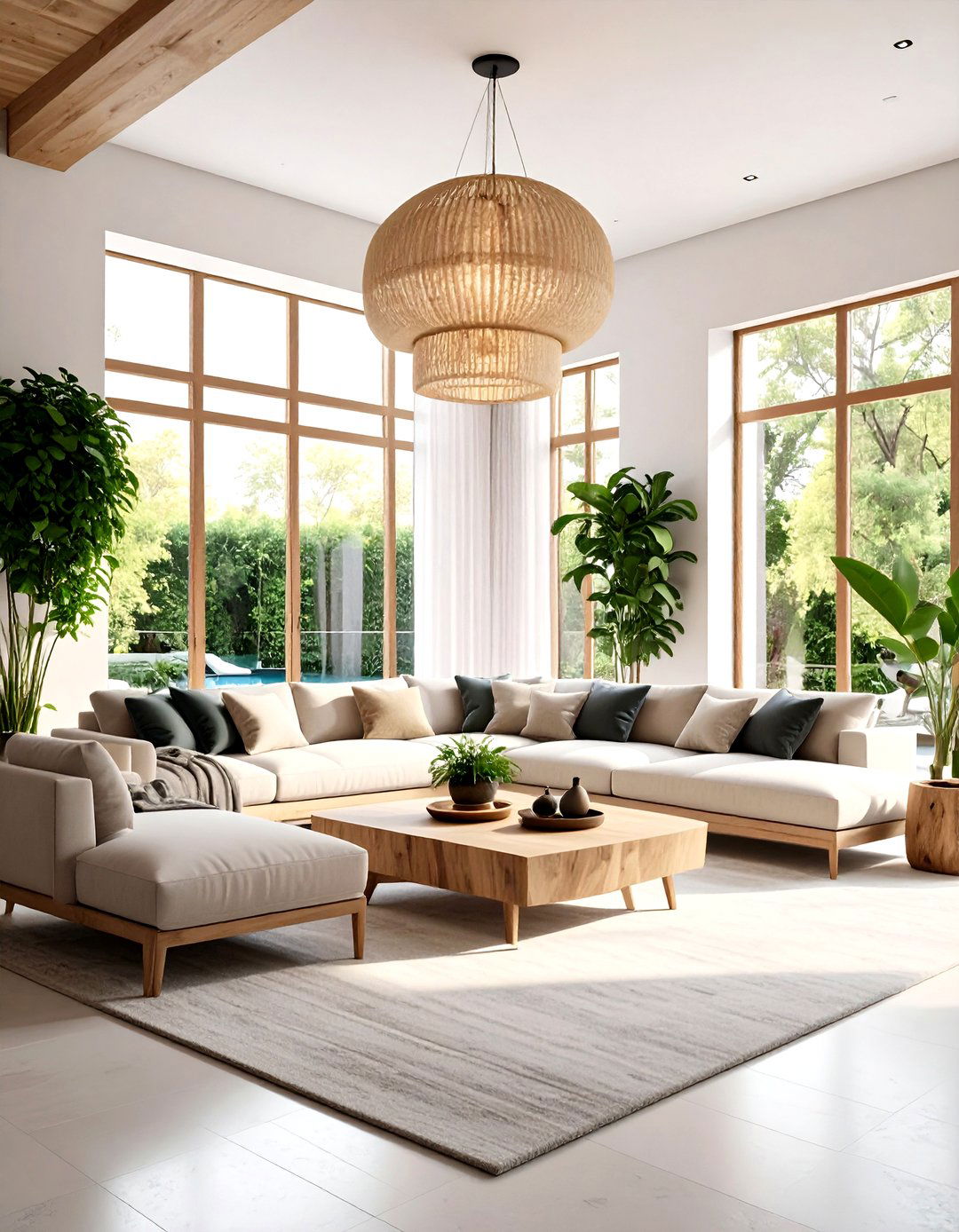
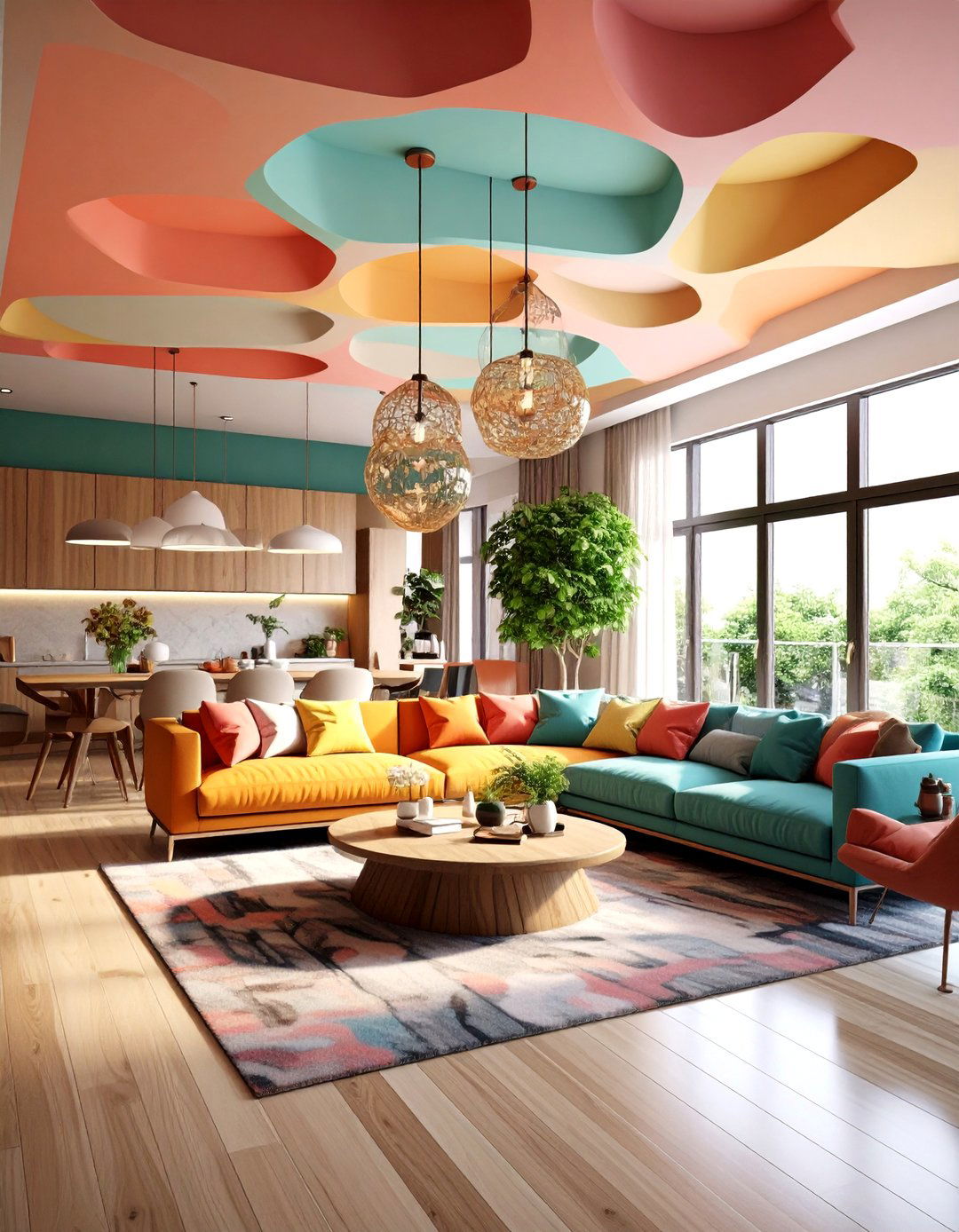

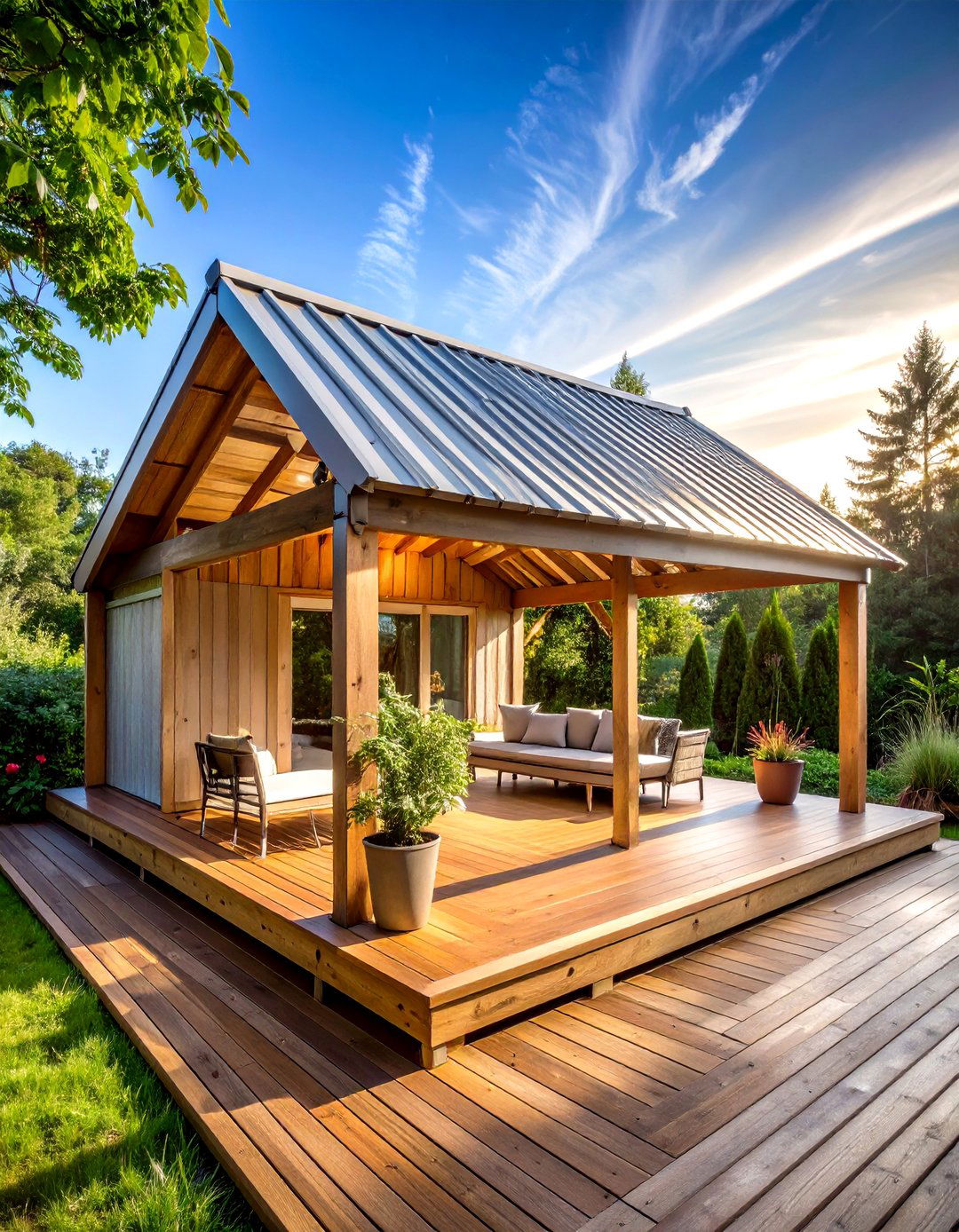
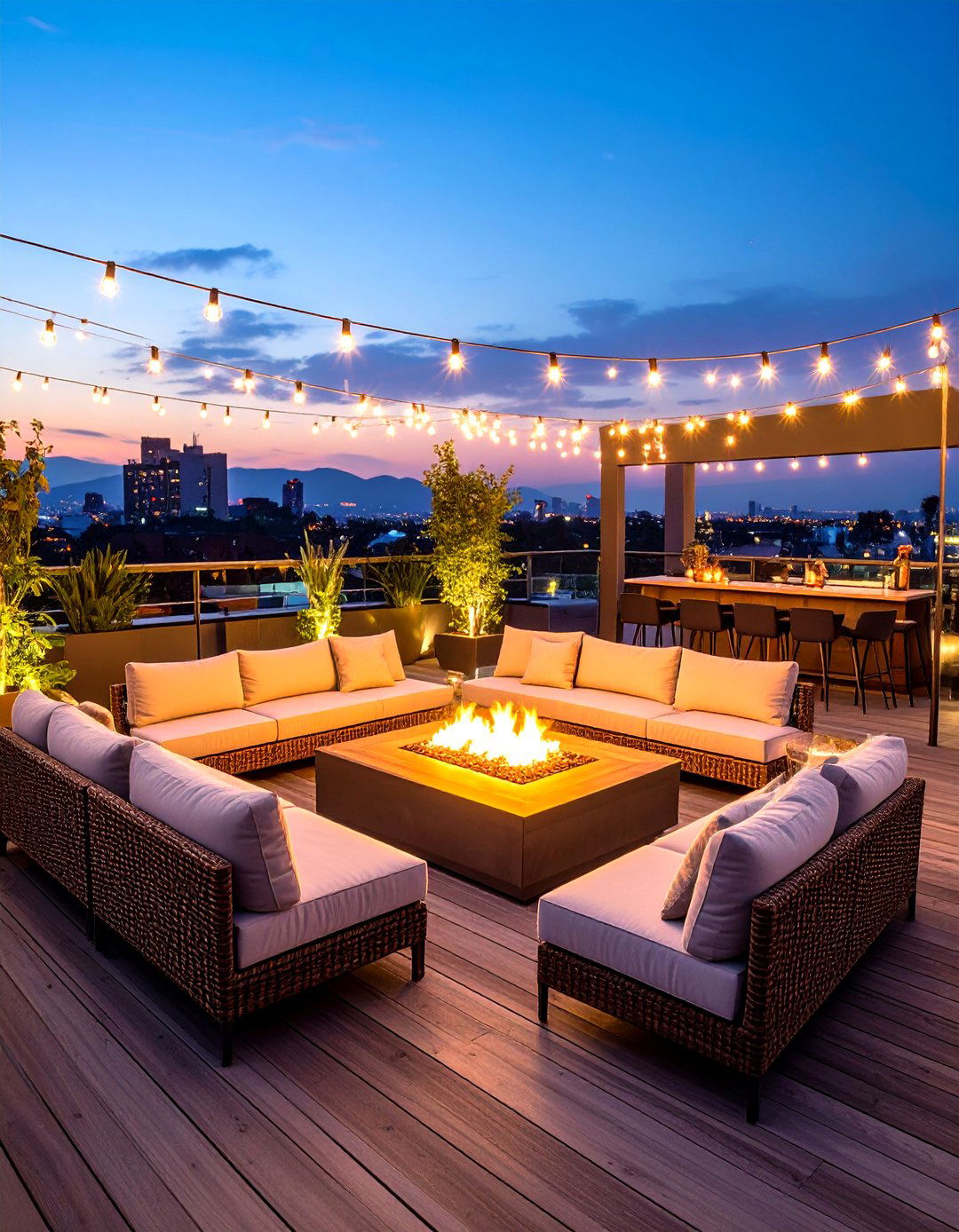
Leave a Reply